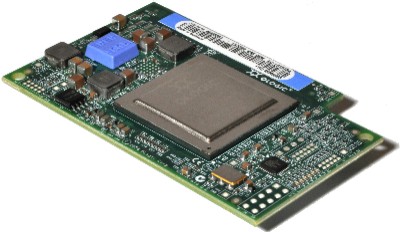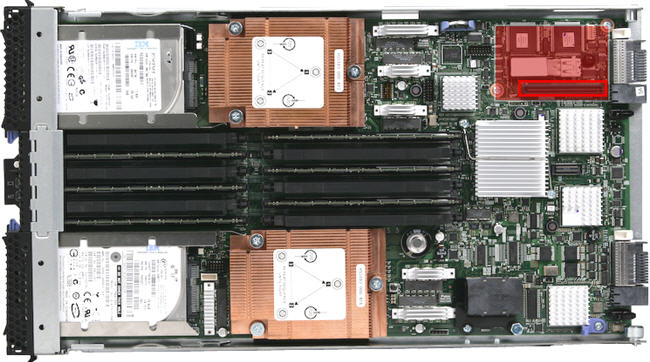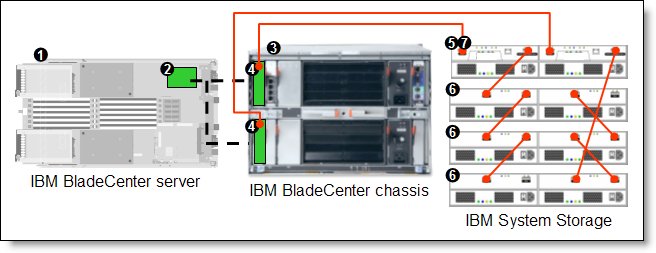Abstract
The QLogic 4Gb Fibre Channel Expansion Card (CIOv) for BladeCenter enables you to quickly and simply connect the BladeCenter servers with CIOv expansion slots to a Fibre Channel SAN. Simply pick any Fibre Channel storage solution and begin accessing data over a high-speed interconnect.
Note: This adapter is withdrawn from marketing.
Introduction
The QLogic 4Gb Fibre Channel Expansion Card (CIOv) for BladeCenter enables you to quickly and simply connect the BladeCenter servers with CIOv expansion slots to a Fibre Channel SAN. Simply pick any Fibre Channel storage solution and begin accessing data over a high-speed interconnect.
This card is installed into the PCI Express CIOv slot of a supported blade server. It provides connections to Fibre Channel-compatible modules located in bays 3 and 4 of supported BladeCenter chassis. A maximum of one QLogic 4Gb Fibre Channel Expansion Card (CIOv) is supported per single-wide (30 mm) blade server.
The QLogic 4Gb Fibre Channel Expansion Card (CIOv) is shown in Figure 1.

Figure 1. QLogic 4Gb Fibre Channel Expansion Card (CIOv)
Did you know?
The adapter connects to the midplane directly, without having to use cables or SFP modules. By eliminating these components for up to 14 servers, the resulting savings alone cover the BladeCenter chassis investment.
The adapter is based on the PCI Express bus, which can be thought of as a high-speed serial replacement of the older technology. Its use offers many benefits, including higher speeds and the ability to send and receive data at the same time.
When using the CIOv adapter, you can simultaneously use a CFFh adapter to enable more types of I/O to supported blade servers such as the HS22 when installed in the BladeCenter H chassis. The innovative design of the CIOv adapter works with the CFFh adapter to support this combination.
Part number information
The part number to order this card is shown in Table 1.
Table 1. Ordering part number and feature code
| Description | Part number | Feature code |
| QLogic 4Gb Fibre Channel Expansion Card (CIOv) for BladeCenter | 46M6065* | 3594 / 8241** |
* Withdrawn from marketing
* The first feature code is for use with the System x sales channel. The second feature code is for use with the Power Systems sales channel
The part number includes the following items:
- One QLogic 4Gb Fibre Channel Expansion Card (CIOv) for BladeCenter
- Documentation package
Features
The QLogic 4Gb Fibre Channel Expansion Card (CIOv) has the following features:
- CIOv form factor
- PCI Express 2.0 host interface
- Support for two full-duplex Fibre Channel ports at 4 Gbps maximum per channel
- Support for Fibre Channel Protocol SCSI (FCP-SCSI) and Fibre Channel Internet Protocol (FC-IP)
- Support for Fibre Channel service (class 3)
- Support for switched fabric, point-to-point, and Fibre Channel Arbitrated Loop (FC-AL) connections
- Configuration and boot support in BIOS and UEFI
Operating environment
The expansion card is supported in this environment:
- Temperature:
- 10 to 35°C (50 to 95°F) at 0 to 914 m (0 to 3,000 ft)
- 10 to 32°C (50 to 90°F) at 914 to 2,133 m (3,000 to 7,000 ft)
- Relative humidity: 8% to 80%
- Maximum altitude: 2,133 m (7,000 ft)
Supported servers and I/O modules
The QLogic 4Gb Fibre Channel Expansion Card (CIOv) is supported in the BladeCenter servers listed in Table 2.
Table 2. Supported servers
| QLogic 4Gb Fibre Channel Expansion Card (CIOv) | 46M6065 | N | N | N | Y | Y | Y | N | N | N | N | N | N | N | Y | Y |
See IBM ServerProven for the latest information on the expansion cards supported by each blade server type: http://ibm.com/servers/eserver/serverproven/compat/us/.
CIOv expansion cards are installed in the CIOv slot in supported servers such as the HS22 as highlighted in red in Figure 2.

Figure 2. Location of the CIOv slot in the BladeCenter HS22
The QLogic 4Gb Fibre Channel Expansion Card (CIOv) supports the I/O modules listed in Table 3. The table also lists the BladeCenter chassis that support each I/O module.
The card requires that a supported I/O module is installed in bay 3 or bay 4 of the chassis, however for redundancy and performance purposes, we recommend that you install two I/O modules in the chassis, one in bay 3 and one in bay 4 of the chassis.
Table 3. I/O module and chassis combinations supported with the QLogic 4Gb Fibre Channel Expansion Card (CIOv)
| Brocade 4 Gb 20-port SAN Switch Module | 32R1812 | N | Y | Y | Y | Y |
| Brocade 4 Gb 10-port SAN Switch Module | 32R1813 | Y | Y | Y | Y | Y |
| Brocade Enterprise 20-port 8Gb SAN Switch Module | 42C1828 | N | Y | Y | N | Y |
| Brocade 20-port 8Gb SAN Switch Module | 44X1920 | N | Y | Y | N | Y |
| Brocade 10-port 8Gb SAN Switch Module | 44X1921 | N | Y | Y | N | Y |
| Cisco 4 Gb 20-port Fibre Channel Switch Module | 39Y9280 | N | Y | Y | Y | Y |
| Cisco 4 Gb 10-port Fibre Channel Switch Module | 39Y9284 | Y | Y | Y | Y | Y |
| McDATA 4 Gb 20-port Fibre Channel Switch Module | 32R1833 | N | Y | Y | Y | Y |
| McDATA 4 Gb 10-port Fibre Channel Switch Module | 32R1905 | N | Y | Y | Y | Y |
| QLogic 4 Gb 20-port Fibre Channel Switch Module | 26R0881 | N | Y | Y | Y | Y |
| QLogic 4 Gb 10-port Fibre Channel Switch Module | 32R1904 | N | Y | Y | Y | Y |
| QLogic 20-port 4 Gb SAN Switch Module | 43W6725 | N | Y | Y | Y | Y |
| QLogic 10-port 4 Gb SAN Switch Module | 43W6724 | Y | Y | Y | Y | Y |
| QLogic 20-Port 8 Gb SAN Switch Module | 44X1905 | Y | Y | Y | Y | Y |
| QLogic 8 Gb Intelligent Pass-thru Module | 44X1907 | Y | Y | Y | Y | Y |
| QLogic 4 Gb Intelligent Pass-thru Module | 43W6723 | Y | Y | Y | Y | Y |
Important considerations:
- The BladeCenter Optical Pass-thru Module, 39Y9316, is not supported.
- The BladeCenter S does not support all I/O modules, as shown in Table 3.
- Many of the I/O modules listed in the table also support the Multi-Switch Interconnect Module (MSIM) and MSIM-HT. However, we do not list that support here since CIOv expansion cards do not support the use of the MSIM or MSIM-HT.
Popular configurations
This section illustrates how the QLogic 4Gb Fibre Channel Expansion Card (CIOv) can be used in configurations. Figure 3 shows the CIOv card installed in a supported blade server, which is in turn installed in a BladeCenter chassis. The chassis is connected to the IBM System Storage DS3400. The RAID functionality is provided by the external storage system.

Figure 3. BladeCenter connected to an external IBM System Storage DS3400 storage solution
The parts used in this configuration are listed in Table 4.
Table 4. Components used when connecting the QLogic 4Gb Fibre Channel Expansion Card (CIOv) to external disk storage (as shown in Figure 3)
| Diagram reference | Part number / Machine type | Description | Quantity |
| Varies | BladeCenter HS22 or other supported server | 1 to 14 | |
| 46M6065 | QLogic 4Gb Fibre Channel Expansion Card (CIOv) | 1 per server | |
| 8677 or 8852* | BladeCenter E, BladeCenter H, or BladeCenter S* | 1 | |
| Varies | Any Brocade, QLogic or Cisco Fibre Channel Switch module | 1 or 2 | |
| 1726-41X or 1726-42X | IBM System Storage DS3400 (Single or Dual Controller) | 1 | |
| 1727 | Optional IBM System Storage EXP3000 (Single or Dual ESM) | 1 to 3 | |
| 39R6536 | DS3000 Partition Expansion License | 1 |
*Note: The expansion card can be installed in servers in the BladeCenter S (8886). However, by doing so you will lose the ability to connect to the BladeCenter S Disk Storage Modules (DSMs). The Fibre Channel expansion card will go in the place of the SAS expansion card needed to connected to the DSMs.
This configuration will also require cabling between the chassis and the storage server and between the storage server and expansion units. (The cable part numbers are not listed in Table 3.)
Supported operating systems
The QLogic 4Gb Fibre Channel Expansion Card (CIOv) supports the following operating systems:
- IBM AIX 5L for POWER Version 5.3
- IBM AIX Version 6.1
- IBM Virtual I/O Server
- IBM i operating system 6.1
- Microsoft Windows Essential Business Server 2008 Premium Edition
- Microsoft Windows Essential Business Server 2008 Standard Edition
- Microsoft Windows Server 2003 R2 Datacenter Edition Unlimited Virtualization
- Microsoft Windows Server 2003, Web Edition
- Microsoft Windows Server 2003/2003 R2, Enterprise Edition
- Microsoft Windows Server 2003/2003 R2, Enterprise x64 Edition
- Microsoft Windows Server 2003/2003 R2, Standard Edition
- Microsoft Windows Server 2003/2003 R2, Standard x64 Edition
- Microsoft Windows Server 2008 R2
- Microsoft Windows Server 2008, Datacenter x64 Edition
- Microsoft Windows Server 2008, Datacenter x86 Edition
- Microsoft Windows Server 2008, Enterprise x64 Edition
- Microsoft Windows Server 2008, Enterprise x86 Edition
- Microsoft Windows Server 2008, Standard x64 Edition
- Microsoft Windows Server 2008, Standard x86 Edition
- Microsoft Windows Server 2008, Web x64 Edition
- Microsoft Windows Server 2008, Web x86 Edition
- Microsoft Windows Small Business Server 2003/2003 R2 Premium Edition
- Microsoft Windows Small Business Server 2003/2003 R2 Standard Edition
- Microsoft Windows Small Business Server 2008 Premium Edition
- Microsoft Windows Small Business Server 2008 Standard Edition
- Red Hat Enterprise Linux 4 AS for x86
- Red Hat Enterprise Linux 4 ES for x86
- Red Hat Enterprise Linux 4 WS/HPC for x86
- Red Hat Enterprise Linux 4 for IBM POWER
- Red Hat Enterprise Linux 5 Server Edition
- Red Hat Enterprise Linux 5 Server Edition with Xen
- Red Hat Enterprise Linux 5 Server with Xen x64 Edition
- Red Hat Enterprise Linux 5 Server x64 Edition
- Red Hat Enterprise Linux 5 for IBM POWER
- SUSE LINUX Enterprise Server 10 for AMD64/EM64T
- SUSE LINUX Enterprise Server 10 for IBM POWER
- SUSE LINUX Enterprise Server 10 for x86
- SUSE LINUX Enterprise Server 10 with Xen for AMD64/EM64T
- SUSE LINUX Enterprise Server 10 with Xen for x86
- SUSE LINUX Enterprise Server 11 for AMD64/EM64T
- SUSE LINUX Enterprise Server 11 for IBM POWER
- SUSE LINUX Enterprise Server 11 with Xen for AMD64/EM64T
- VMware ESX 3.5
- VMware ESX 4.0
- VMware ESXi 3.5
- VMware ESXi 4.0
See IBM ServerProven for the latest information on the specific versions and service packs supported: http://ibm.com/servers/eserver/serverproven/compat/us/. Select the blade server and then select the expansion card to see the supported operating systems.
Related product families
Product families related to this document are the following:
Trademarks
Lenovo and the Lenovo logo are trademarks or registered trademarks of Lenovo in the United States, other countries, or both. A current list of Lenovo trademarks is available on the Web at https://www.lenovo.com/us/en/legal/copytrade/.
The following terms are trademarks of Lenovo in the United States, other countries, or both:
Lenovo®
BladeCenter®
ServerProven®
System x®
The following terms are trademarks of other companies:
Linux® is the trademark of Linus Torvalds in the U.S. and other countries.
Microsoft®, Windows Server®, and Windows® are trademarks of Microsoft Corporation in the United States, other countries, or both.
IBM®, AIX®, and ibm.com® are trademarks of IBM in the United States, other countries, or both.
Other company, product, or service names may be trademarks or service marks of others.
